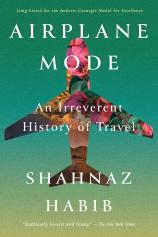Airplane Mode: An Irreverent History of Travel
Review
Airplane Mode: An Irreverent History of Travel
As soon as the most intense months of the COVID-19 pandemic started to wane, many of my friends and family’s first thoughts turned to travel, eager to book the cruises and treks that had been only the stuff of imagination for so long. Some stoked their imaginary journeys by reading travel guidebooks or essays. But, as Shahnaz Habib’s excellent new book points out, these resources only provide part of the story.
Habib, who grew up in Kerala, India, but now lives in Brooklyn with her husband and child, is primarily a translator. Perhaps that outlook --- along with her own identity as a relatively recent immigrant --- enables her to view the history of travel, and the ways we write, talk about and record our travel, through a different lens. In a series of wide-ranging chapters that also can be read largely as stand-alone essays, Habib explores the current state of travel for those who come from the so-called Third World (a label she herself uses) and the complicated history of travel, particularly as it relates to capitalism and European colonialism.
"If your holiday plans include travel, AIRPLANE MODE is the perfect, thoughtful book to pack in your carry-on. But even if you’re staying home, Habib’s smart, insightful writing will give all readers a new window on the world."
Tourism, Habib argues, was sparked by the Industrial Revolution in several key ways. New money and a growing middle class opened up the possibility of international travel to more Europeans and Americans, who also benefited from a rapidly growing transportation infrastructure abroad. It was designed, as Habib traces, to facilitate the plundering of resources (and, in some cases, people) from those countries, in turn enriching the white colonialists who subsequently used their growing disposable income to tour so-called exotic locales. Habib spends one particularly insightful chapter discussing Phileas Fogg, the protagonist of Jules Vernes’ AROUND THE WORLD IN EIGHTY DAYS. Fogg’s daring feat was made possible, she argues, not by his fearless or adventurous spirit, but by the decades of colonial expansion that paved the way for him and whose evidence is right there in the book --- if you look for it.
The ways in which largely white, male travel writers from Europe and the United States chronicle their experience of travel to distant places is also telling. Habib identifies a tradition of “pseudiscovery,” the notion that various landmarks both natural and human-made were unknown or “lost” until being encountered by a white traveler (one example is Angkor Wat), as well as how most conventional travel narratives speak of interactions with nature in terms of battle: “conquering a mountain,” etc. The local people whose daily lives make these kinds of “conquests” possible are largely invisible in such narratives; here she centers them.
Habib’s exploration is not only historical in nature. She also writes about her own experience of “passportism,” recounting a time when her American-born husband wanted to take a spontaneous European vacation before she had gained US citizenship. He was unprepared by the various visas and other bureaucratic hoops that were required for her to make the identical trip that he, with his American credentials, could book with ease.
In one of the more personal chapters, Habib writes about traveling through Brooklyn by bus, in the early months of her daughter’s life, and how looking at her adopted city through a bus window and interacting with fellow passengers changed her outlook on both this place and her new identity as a mother. If your holiday plans include travel, AIRPLANE MODE is the perfect, thoughtful book to pack in your carry-on. But even if you’re staying home, Habib’s smart, insightful writing will give all readers a new window on the world.
Reviewed by Norah Piehl on December 16, 2023
Airplane Mode: An Irreverent History of Travel
- Publication Date: December 3, 2024
- Genres: Cultural Studies, Essays, History, Nonfiction, Travel
- Paperback: 288 pages
- Publisher: Catapult
- ISBN-10: 1646222393
- ISBN-13: 9781646222391



